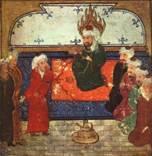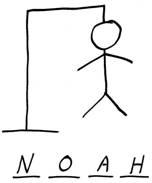Rise of Islam
RISE OF ISLAM

Objectives:
- Students should be able to name Mohammed as the founder of Islam.
- Students should be able to name “Allah” as the god of Islam.
- Students should know that the book of Islam is called the “Koran”.
- Students should know that followers of Mohammed are called Moslems (or Muslims).
Possible Lesson Plan:
- Open with prayer.
- Tell the story of Mohammed – have pictures of deserts and camels to show:
In the world of the Arabs in northern Africa, a world of camels and deserts, there arose a new teacher. His name was Mohammed. Mohammed was born in the city of Mecca about 600 years after the time of Jesus. He was just a poor camel driver, a servant of a wealthy Arabian lady. The lady fell in love with the servant and they were married. And for many years, the camel driver and his wife lived a quiet life in the town of Mecca. Then, when he was forty years old, Mohammed thought that an angel told him that he should write a new book of teachings about a god he called Allah. He called his book the Koran. Mohammed did not believe that Jesus was the Son of God or that Jesus rose from the dead. In fact, Mohammed believed that he himself was greater and wiser than Jesus! His wife believed Mohammed and became his first follower.
At first, the Arabic people laughed at Mohammed and plotted to get rid of Mohammed. But, Mohammed heard of the plot to kill him, and ran away with his wife and friends. He fled to the town of Medina. The word for “flight” in Arabic is “hegira”; his journey is called the “Hegira” by his followers to this day. For awhile Mohammed taught his new ideas in the city of Medina. He called his new religion Islam and his followers were called Moslems. But soon, Mohammed was not happy to have only the followers who liked his new teachings. He told all of his followers that they would go right to heaven if they were killed following him in battle. They began to force people in Arabia and in other lands to become Moslems or die. Soon, Mohammed and his followers conquered all of Arabia. Mohammed died, but his followers continued to fight wars to conquer lands for their new ideas. They traveled to Persia, to all of northern Africa, to Spain and to France, conquering the Christian lands, until they were stopped in France by the great warrior, Charles the Hammer, at the Battle of Tours. They even conquered Jerusalem and the Holy Land where Jesus had taught and lived! Soon they were at the doorstep of Constantinople, the capital of the great Christian Byzantine Empire built by the Emperor Constantine 400 years before.
For many years the Arabic followers of Mohammed tried to conquer Constantinople. Battle after battle was fought. The people of Constantinople poured boiling oil on the attacking Moslems. Finally, Emperor Leo III defeated the Moslems in 717 AD and made them flee behind the mountains. They did not attack Constantinople again for hundreds of years. Christians were safe to worship the Lord in the lands of the Byzantine Empire again.
- Who were the Arabs? Remind the students of the story of Abraham, and his sons Ishmael and Isaac. Look at the pictures in their picture Bibles and retell the story. The Arabs were the great-great-great-great…grandchildren of Ishmael, who fled with his mother Hagar into the desert. The children of Isaac became what people? (the Jews or Hebrews) Look at pictures of Arabic life – of camels, tents, deserts.
 Play a learning game: Hangman – Choose some important words from today’s lesson. Draw a gallows with little lines under it for each letter of the word. Students take turns guessing a letter that might be in the word you have chosen. If the letter is in the word, write it on the correct line. If not, draw a body part. Will the man get hanged before the word is uncoded? Some potential words:
Play a learning game: Hangman – Choose some important words from today’s lesson. Draw a gallows with little lines under it for each letter of the word. Students take turns guessing a letter that might be in the word you have chosen. If the letter is in the word, write it on the correct line. If not, draw a body part. Will the man get hanged before the word is uncoded? Some potential words:
Mohammed Mecca Moslem
Medina Islam Hegira
- Make a Salt Map: Mix salt dough. Color some blue (for water), some light yellow (for Moslem lands), and some green or red (for Christian lands). Take the map on the next page. Glue onto a firm base – piece of cardboard, lid of box, Styrofoam plate. Have students fill in outlines with dough, reviewing all the time what the various geographical features are. Where is the Nile River? Where is Arabia? Put little flags on toothpicks to mark Mecca and Medina, Constantinople and Rome.
- Close with prayer: Lord, help me not to be led away from You by false teachers with new ideas.